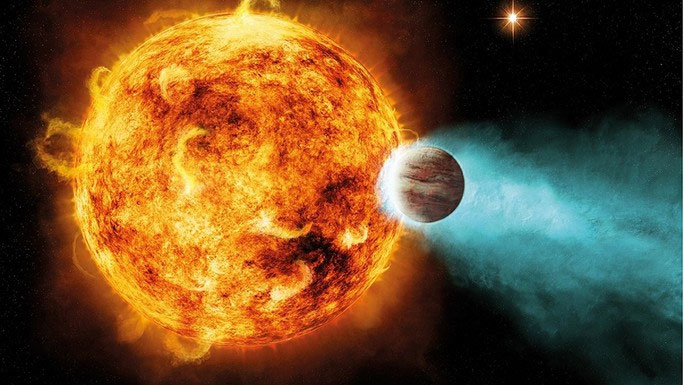Discovery of 'dry bone' planet containing terrifying secrets
A newly discovered exoplanet has revealed completely absurd properties, leaving scientists baffled and contemplating terrifying scenarios about its past.
According to Science Alert, it is the planet TOI-332b , orbiting an orange dwarf star 727 light years from Earth.
Measurements based on the planet's effect on the light of its parent star each time it passes by allowed the team of scientists, led by astrophysicist Ares Osborn from the University of Warwick (UK), to calculate that it is a world with a radius 3.2 times that of Earth, orbiting its parent star every 18.72 hours.

Graphic depicting a giant planet with its atmosphere blown away - (Photo: SCIENCE ALERT).
More interestingly, the planet lies in a region called the "Neptune desert , " a mysterious region around some stars that is devoid of Neptune-sized planets, a type of planet that is relatively abundant.
TOI-332b has completely baffled scientists. Despite being located in the Neptune desert, it is still roughly the same size as Neptune , a planet with a radius 3.88 times that of Earth.
Yet it is 57.2 times more massive than our world, while Neptune has a mass of just 17.15.
This size and weight would make it a world with a terrifying density of 9.6 g/m 3 , which is heavier than a solid block of iron of the same size!
Modeling observational data, scientists believe it has a giant, dense iron core, with a rocky mantle and a thin atmosphere of hydrogen and helium, although it should have been a gas giant like Jupiter when it was born in this region.
For a world so close to its star, photoevaporation—which causes the atmosphere to slowly leak into space—is possible, but it cannot explain the transformation of an entire gas giant into a bare lump of iron.
There are two horrifying scenarios for how the planet became in its current " skeleton " state .
- In the first scenario, it could have formed farther away from its current location , then moved closer to its parent star as it evolved. The gradual heating from the shrinking distance and changes deep within the planet would have stripped away its atmosphere.
- It is also possible that it was the victim of a massive planetary impact . The catastrophic impact blew away the entire atmosphere.
- A third, less likely scenario, is that it was born as a weird "dry bone" like that, with no atmosphere accumulating in the first place.
Regardless, TOI-332b remains a strange, alien world that scientists hope to learn more about with more advanced observational tools, following this initial discovery.
- The most terrifying tourist destinations on the planet
- New discovery of planet named
- Discover the most terrifying monster of the planet under the ocean
- Terrifying discovery near Earth: Planet 'stolen soul'
- Revealed from the bones of Bosnian genocide victims
- The world's first 3D jaw bone graft surgery
- WASP-43b - New terrifying planet than hell
- What is bone cancer?
- Discovered 1,000-year-old ink pen made of bone in Ireland
- Coming to the press conference announcing the discovery of the
- New circumbinary planet detection revolves around two stars
- The 3D printer
 Van Allen's belt and evidence that the Apollo 11 mission to the Moon was myth
Van Allen's belt and evidence that the Apollo 11 mission to the Moon was myth The levels of civilization in the universe (Kardashev scale)
The levels of civilization in the universe (Kardashev scale) Today Mars, the sun and the Earth are aligned
Today Mars, the sun and the Earth are aligned The Amazon owner announced a secret plan to build a space base for thousands of people
The Amazon owner announced a secret plan to build a space base for thousands of people